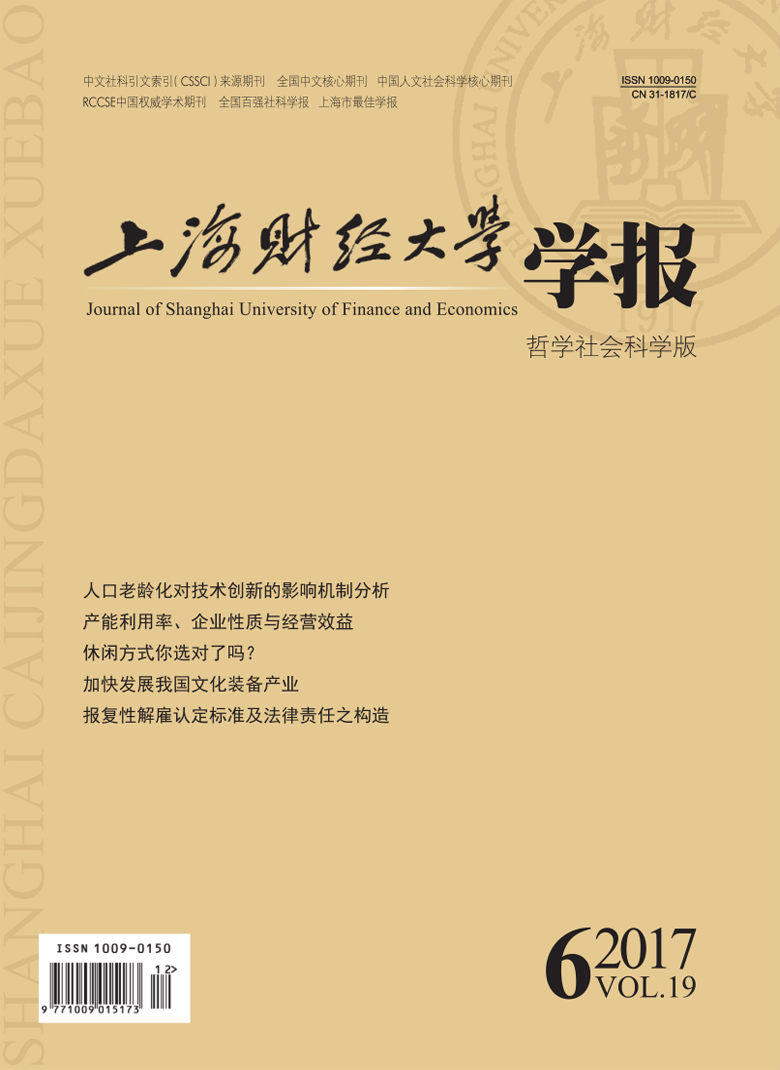在老龄化程度加深以及我国经济对技术创新日渐倚重的双重背景下,研究人口老龄化如何影响我国的技术创新具有重要意义。文章基于动态因子模型,从创新投入、创新产出、创新绩效、协同创新能力、创新环境五个方面测算了我国1990–2014年29个省份的技术创新能力,并构建了新的技术创新综合能力指数。在此基础上,运用动态面板模型,文章发现人口老龄化对技术创新产生两种对立效应:一方面,人口老龄化通过提高科研工作者的劳动效率对技术创新产生积极影响,具有“劳动效率正效应”;另一方面,人口老龄化通过降低人力资本投资水平以及加重老龄负担、挤占创新资源对技术创新产生消极影响,具有“人力资本负效应”和“老龄负担负效应”。这一研究对如何应对我国人口老龄化的挑战具有实践意义和政策参考。
人口老龄化对技术创新的影响机制分析——基于DFA方法的创新评价和动态面板模型
摘要
参考文献
摘要
关键词
1 白俊红, 蒋伏心. 协同创新、空间关联与区域创新绩效[J]. 经济研究, 2015, (7).
2 陈钊, 陆铭, 金煜. 中国人力资本和教育发展的区域差异: 对于面板数据的估算[J]. 世界经济, 2004, (12).
3 崔敏, 魏修建. 服务业各行业生产率变迁与内部结构异质性[J]. 数量经济技术经济研究, 2015, (4).
4 胡伟略. 关于人口老龄化与技术进步的关系问题[J]. 数量经济技术经济研究, 1991, (11).
5 贾智莲, 卢洪友. 财政分权与教育及民生类公共品供给的有效性——基于中国省级面板数据的实证分析[J]. 数量经济技术经济研究, 2010, (6).
6 李国璋, 周彩云, 江金荣. 区域全要素生产率的估算及其对地区差距的贡献[J]. 数量经济技术经济研究, 2010, (5).
7 马三希, 姚东旻. 人口老龄化会影响创新吗? [A]. 马光远. 中国创造力报告(2012—2013)——创新驱动中国梦[C]. 北京: 社会科学文献出版社, 2013.
8 牛泽东, 张倩肖. 中国装备制造业的技术创新效率[J]. 数量经济技术经济研究, 2012, (11).
9 田雪原, 胡伟略, 杨永超. 日本人口老龄化与经济技术进步——赴日考察及学术交流报告[J]. 中国人口科学, 1990, (6).
10 汪伟, 姜振茂. 人口老龄化对技术进步的影响研究综述[J]. 中国人口科学, 2016, (3).
11 吴显英. 区域技术创新能力评价中的因子分析[J]. 哈尔滨工程大学学报, 2003, (2).
12 吴延兵. R&D存量、知识函数与生产效率[J]. 经济学(季刊), 2006, (3).
13 姚东旻, 宁静, 韦诗言. 老龄化如何影响科技创新[J]. 世界经济, 2017, (4).
14 朱平芳, 徐伟民. 政府的科技激励政策对大中型工业企业R&D投入及其专利产出的影响——上海市的实证研究[J]. 经济研究, 2003, (6).
15 Ashworth M J. Preserving knowledge legacies: Workforce aging, turnover and human resource issues in the US electric power industry[J]. International Journal of Human Resource Management, 2006, 17(9): 1659-1688.
16 Behaghel L, Greenan N. Training and age-biased technical change[J]. Annals of Economics and Statistics, 2010, 99-100: 317-342.
17 Coppi R P R, Zannella F. L’analisi fattoriale di una serie temporale multipla relativa allo stesso insieme di unità statistiche[A]. Proceedings of the XXIX scientific meeting of the Italian statistical society[C]. Bologna: Italian Statistical Society, 1978.
18 Federici A, Mazzitelli A. Dynamic factor analysis with STATA[A]. 2nd Italian state users Group meeting[C]. Milano, 2005.
19 Feyrer J. Demographics and productivity[R]. Dartmouth College Working Paper No. 02-10, 2002.
20 Froscb K, Tivig T. Age, human capital and the geography of innovation[A]. Kuhn M, Ochsen C, eds. Labour markets and demographic change[M]. Wiesbaden: VS Verlagfür Sozialwissenschaften, 2009.
21 Gonzales-Eiras M, Niepelt D. Aging, government budgets, retirement and growth[J]. European Economic Review, 2012, 56(1): 97-115.
22 Habakkuk H J. American and british technology in the nineteenth century: The search for labor-saving inventions[M]. London: Cambridge University Press, 1962.
23 Hsu P H, Tian X, Xu Y. Financial development and innovation: cross-country evidence[J]. Journal of Financial Economics, 2014, 112(1): 116-135.
24 Ilmakunnas P, Maliranta M. Aging, labor turnover and firm performance[R]. ETLA Discussion Papers No. 1092, 2007.
25 Kuhn M, Hetze P. Team composition and knowledge transfer within an ageing workforce[R]. Rostock Center Discussion Paper, 2007.
26 Lee R, Mason A. Fertility, human capital, and economic growth over the demographic transition[J]. European Journal of Population, 2010, 26(2): 159-182.
27 Noda H. Population aging and creative destruction[J]. Journal of Economic Research, 2011, 16(1): 29-58.
28 Romer P M. Crazy explanations for the productivity slowdown[J]. NBER Macroeconomics Annual, 1987, 2: 163-202.
29 Scarth W. Population aging, productivity and living standards[J]. The Review of Economic Performance and Social Progress, 2002, 2: 145-156.
引用本文
汪伟, 姜振茂. 人口老龄化对技术创新的影响机制分析——基于DFA方法的创新评价和动态面板模型[J]. 上海财经大学学报, 2017, 19(6): 4–17.
导出参考文献,格式为:





 12991
12991  15510
15510

